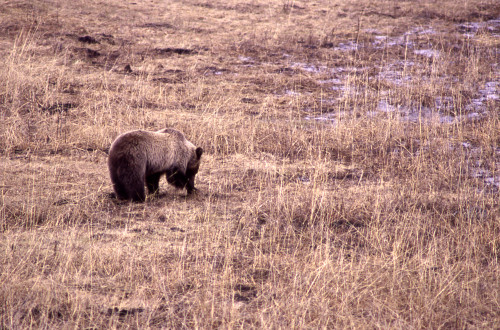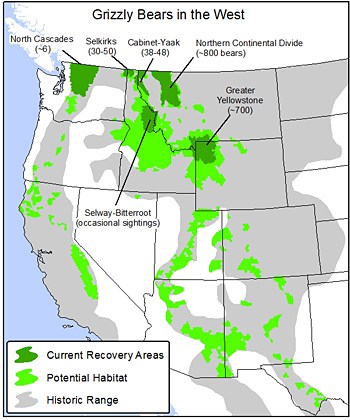Grizzly Bears In the Pacific Northwest: A Natural History (Part 3)

With the near extermination of the grizzly came a tremendous loss to the ecosystem. Grizzlies play an important role in the natural environment as pollinators, seed dispersers, and soil aerators. Grizzlies, by digging with their long claws for grubs and flower bulbs, will upturn many rocks and help to aerate the soil. Through this aeration process, the soil becomes healthier from the turning of nutrients and loosing of the soil, which allows water to flow more freely to the roots of the plants and allowing those plants to better absorb nutrients. By digging and upturning the soil, grizzlies also assist in the pollination and seed dispersal process as well.
The grizzly is what is known as an “umbrella species.” In an article published on The Encyclopedia of Earth website Nathaly Agosto Fillion describes this term, “The concept of an umbrella species has been used by conservation practitioners to provide protection for other species using the same habitat as the umbrella species. As the term implies, a species casts an umbrella over the other species by being more or equally sensitive to habitat changes. Thus monitoring this one species and managing for its continued success results in the maintenance of high quality habitat for the other species in the area. Animals identified as umbrella species typically have large home ranges that cover multiple habitat types. Therefore, protecting the umbrella species effectively protects many habitat types and the many species that depend on those habitats.” (Filion, 2014).
The concept of the grizzly being an umbrella species would provide evidence that the North Cascades Ecosystem is healthy and that other species would be flourishing as well. Having the grizzly bear as a member of the ecosystem and with the anticipated restoration of the fisher, a small carnivore of the weasel family, the North Cascades would be one of only a few North American ecosystems that contain its original carnivore species prior to European settlement (NPS, 2015).
With the concept of the grizzly being an umbrella species, and the role it plays in the ecosystem, it makes sense to plan a restoration of the species to the North Cascades. But protection of grizzly bears has come slowly, and almost to the point where it would have been too late. Enos Mills, Father of Rocky Mountain National Park, was calling for the protection of the grizzly as early as 1918, when people were still rapidly killing grizzlies in the west:
“Most big game has had some protection for years; the grizzly has had none. He is not a bad fellow, there is no just claim against him, but he has paid the penalty of being misunderstood. He has been classed as a menace and relentlessly pursued as though a dangerous criminal. Men follow him the year round, with guns, dogs, horses, traps, and poison. He is even trailed to the hibernating den and slaughtered without any chance for his life. Fear of bears and prejudice against them is all too often taught and developed in childhood. Mothers and nurses hush children by telling them; ‘Bears will get you if you’re not good.’ People, however, are now learning that bears are not ferocious, that they do not eat human flesh, and that in the wilds the grizzly flees from man as though from pestilence.” (Mills, 167)
It would take another 57 years before Mills’ dream to become a reality. In December 1973 the United States Congress passed the Endangered Species Act (ESA). Overseen and managed by the United States Fish and Wildlife Service, the Endangered Species Act is designed to protect and recover imperiled species and the habitat they depend on. The U.S. Fish and Wildlife Service states that, “Under the ESA, species may be listed as either endangered or threatened. ‘Endangered’ means a species is in danger of extinction throughout all or a significant portion of its range. ‘Threatened’ means a species is likely to become endangered within the foreseeable future. All species of plants and animals, except pest insects, are eligible for listing as endangered or threatened.” (FWS, 2013).

In July 1975 the grizzly bear was listed as a threatened species in the lower 48 states. The assault and attempted extermination of the grizzly came to a sudden halt and an attempt to recover the diminishing population began. With the listing of the grizzly bear as a threatened species in the lower 48 states, the U.S. Fish and Wildlife Service have established six grizzly bear recovery zones in order to help recover the population of the grizzly. The first of these recovery zones were established in the Northern Rockies in areas that already had confirmed grizzly populations. In 1997 the North Cascades Ecosystem was added as a grizzly recovery zone. There are now five recovery zones where grizzlies still remain: The Northern Continental Divide, Yellowstone, Cabinet-Yak, Selkirk, and North Cascades Ecosystems. The Bitterroot Ecosystem in Eastern Idaho is also an included recovery zone that does not have any confirmed grizzlies.
Three of the six grizzly recovery zones include large portions of National Park land. The three national parks included in the recovery efforts are Glacier, Yellowstone, and North Cascades. National parks presented a logical choice to establish recovery zones as they receive the most protection of any other public land agency in the country. In 1918 Enos Mills wrote, “National parks are developing a friendly interest in grizzlies, and there is a growing appreciation of the grizzlies’ true worth. But just at present this appreciation and this sentiment are not strong enough to protect the grizzly without the formal assistance of a grizzly protection law.” (Mills, 171). In these almost prophetic words, Mills seemed to know that unless the federal government intervened, the grizzly was doomed. It was not until the grizzlies received federal protection that the tide started to turn in favor of the grizzly and the grizzly population began to slowly regain ground.
Mike has also written Part One and Part Two of this series, along with a series on wolves.

